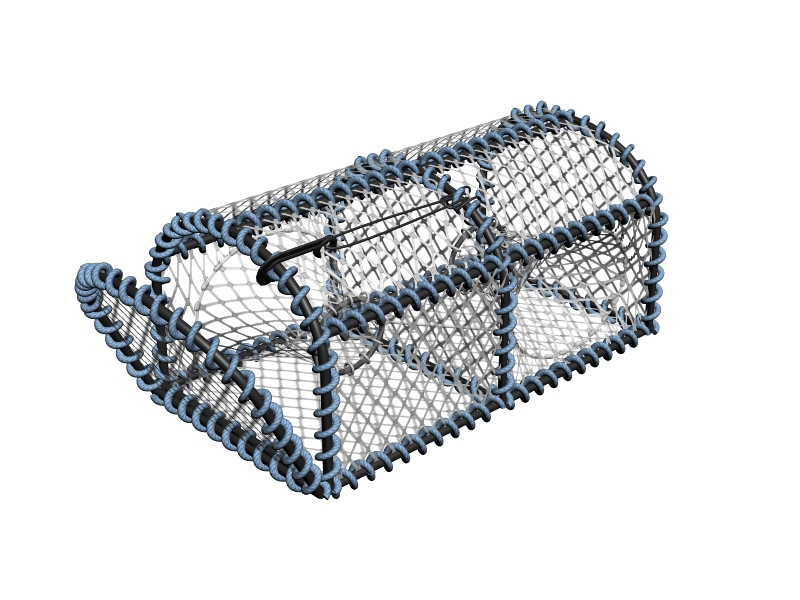Pots and Trap - Nephrops
Alternative names
-
- Creels
- Pots
- Prawn creels
- Traps
Summary
Nephrops creels or prawn creels as they are generally called, are of the basic D creel design but of much lighter construction than that of a lobster or crab pot.
They usually have the standard two entrances in the side and almost always have plastic rings fitted to the entrances to keep the entrance open. These are known as hard eyes and they make entry into the creel easy for the Nephrops. They are usually worked in long fleets of up to 100 creels.

Environmental impact
By-catch in prawn creels is minimal and usually confined to small animals of the target species and a few small fish. This can be minimised by the use of appropriate mesh sizes in the cover netting and the use of relevant escape gaps. Any by-catch in the pots can be easily removed from the creel and released back into the sea immediately without harm. The hard eyes help to release any small fish that stray into the creels.
Seabed impact with nephrops creels is again limited to very light contact of the traps and ropes. If small anchors are used at the ends of the fleet there will be a small degree of penetration of the seabed but more often flat weights are used when there will be no real penetration. There may be some abrasion from the weight during spells of bad weather.
Often prawn gear is set in deep or sheltered waters where the wave action will have very little effect on the seabed therefore no movement of the weights. There may a slight movement of the gear and the ropes on the seabed particularly in poor weather but they are so lightweight that this will not have much effect on the seabed.
Ghost fishing is not that common with nephrops creels. The fishermen do not encounter many losses of gear as it’s often in shot deep or sheltered waters. Even when these creels are lost or lay on the seabed for a long time any nephrops or other shellfish that enter can easily escape through the hard entrances
Other information
In some areas of the UK, particularly the West coast of Scotland, Nephrops (langoustine), referred to by the fishermen as ‘prawns’, are caught using creels. These prawn creels, as they are generally called, are of the basic D creel design but of much lighter construction than that of a lobster or crab pot. They usually have the standard two entrances in the side and almost always have plastic rings fitted to the entrances to keep the entrance open. These are known as hard eyes and they make entry into the creel easy for the Nephrops.
As with any hard eyed creel, if not hauled daily, many of the creatures will soon escape. These creels are generally set in deeper water on soft seabeds of mud and sand where the Nephrops live in burrows. In these areas, there is much less chance of the creels moving and getting abraded by contact with rocks and stones, therefore, there is need for only a lightweight rope to be wrapped around the frame of the creel to prevent damage.
Most skippers using Nephrops creels, even on the smaller vessels, use large fleets often around 100 creels. There will usually be some form of anchor or weight at each end of the fleet to help prevent the fleet being moved by strong tides and rough seas. They are baited with some form of fish, often salted or frozen herring or mackerel is used. The gear will be hauled and shot on a daily basis in the usual way.
The mesh size of these creels will be chosen to allow the release of the very small Nephrops and any small fish. When the gear is hauled and the catch removed, the retained Nephrops are usually selected by size and placed in individual sections or ‘tubes’ in a box that is then immersed in a tank of sea water to keep them alive and in prime condition.
Most of the prime quality Nephrops will be transported, still alive, to the lucrative markets in France and Spain either by vivier lorry or by air freight. There is negligible by-catch or discarding in the creel Nephrops creel fishery. Due to the type of seabed the gear is worked on, and the lightweight gear used, the impact on the seabed should be minimal.
Gear classification
Main target species (UK)
-
- Nephrops
Possible bycatch
-
- Crabs
- Immature round fish
- Juveniles of the target species
- Velvet crab
- Small fish
- Very little bycatch